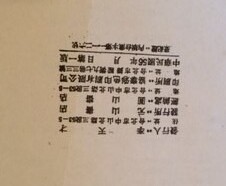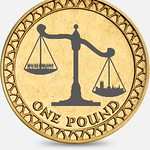
About UsThe Numismatic Bibliomania Society is a non-profit organization promoting numismatic literature. For more information please see our web site at coinbooks.org SubscriptionsThose wishing to become new E-Sylum subscribers (or wishing to Unsubscribe) can go to the following web page link MembershipThere is a membership application available on the web site Membership Application To join, print the application and return it with your check to the address printed on the application. Membership is only $20 to addresses in the U.S., $25 for First Class mail, and $30 elsewhere. For those without web access, write to: David M. Sundman, Treasurer AsylumFor Asylum mailing address changes and other membership questions, contact David at this email address: dsundman@LittletonCoin.com SubmissionsTo submit items for publication in The E-Sylum, just Reply to this message, or write to the Editor at this address: whomren@gmail.com
BUY THE BOOK BEFORE THE COIN |
- WAYNE'S WORDS: THE E-SYLUM SEPTEMBER 14, 2014
- LAKE BOOKS SALE #119 PRICES REALIZED AVAILABLE
- ANS SEEKS TO APPOINT A LIBRARIAN
- NEW BOOK: 1904-O MORGAN DOLLAR ATTRIBUTION
- NEW BOOKS IN THE MONETA SERIES: #176-178
- R.L. MILES AND NUMISMATIC LITERATURE
- MORE ON THE RED BOOK KNOCKOFF
- WHITMAN'S 2ND AMENDMENT IMPRINT
- NOTES FROM E-SYLUM READERS: SEPTEMBER 14, 2014
- CONGRESSIONAL GOLD MEDALS FOR 9/11 HEROES
- MORE ON THE MONNAIE DE PARIS MEDAL CATALOGS
- PARIS MINT PRIVY MARKS APPEARING ON MEDALS
- A MECKLENBURG DECLARATION CITATION
- MORE ON CONFEDERATE MINTING IN NEW ORLEANS
- THE 'CONFEDERATE' 1861-D GOLD DOLLAR
- VALUING THE NEWLY-FOUND OAK TREE THREEPENCE
- THE LYN KNIGHT WORLD REPLACEMENT NOTE SALE
- PHILIP DIEHL ON FIRST STRIKE COINAGE
- NEW ORLEANS MINT REOPENING SILVER BAR QUESTIONED
- FIRST DOLLAR ADJUSTED IN THE NEW ORLEANS MINT
- WHITMAN CALLS FOR CHERRYPICKERS' VOLUNTEERS
- THE 'ALONGSIDE NIGHT' GOLD LIBERTY COIN
- U.S. MARSHALS HUNT FOR TOMMY THOMPSON
- WAYNE'S NUMISMATIC DIARY: SEPTEMBER 14, 2014
- A DESIGN CONTEST FOR THE POUND COIN REVERSE
- CHRISTIE'S TO SELL JOHN IRVING ARCTIC MEDAL
- COINAGE OF THE BARBARIAN INVADERS
- HASLEMERE AND THE LEGENDARY ANCIENT COIN FORGERS
- WORLD'S FIRST ECCENTRIC BIMETALLIC COIN
- IS THERE REALLY SUCH A THING AS A COIN SHOP?
- BALDWIN'S TO SELL 18TH CENTURY BRITISH TOKENS
- 18TH CENTURY BRITISH TOKEN REFERENCES
- RARE £10 MILLION UK TREASURY BILL OFFERED
- BANK OF ISRAEL ANNOUNCES NEW 50 SHEKEL BANKNOTE
- WORLD'S LARGEST COIN MOSAIC RECORD SET
- FEATURED WEB SITE: THE COLUMBIA FARTHING
Click here to access the complete archive
To comment or submit articles, reply to whomren@gmail.com
WAYNE'S WORDS: THE E-SYLUM SEPTEMBER 14, 2014

New subscribers this week include: Lower Cape Fear Coin Club members Michael McKinnon, Calvin Lindsey, and Willie France, courtesy of Robert Neale; Harriette Moore of Baldwin's; and Christopher Muns. Welcome aboard! We now have 1,768 subscribers.
This week we open with an update from Fred Lake, the ANS's search for a new librarian, two new books, and thoughts on numismatic literature from R.L. "Skinny" Miles.
Other topics include the Chinese counterfeit Red Book, Paris Mint privy marks, the 'Confederate' gold dollar, coin shops, replacement notes, first strikes, 18th century British token reference works, the Columbia Farthing, the pound coin reverse design contest, and the world's largest coin mosaic.
To learn more about 1904-O dollar varieties, The Essay-Proof Journal, the Wal-Mart Golden dollars, the first dollar adjusted in the New Orleans Mint, 1950-D nickels, the Arctic Medal, coinage of the barbarian invaders and the world's first eccentric bimetallic coin, read on. Have a great week, everyone!
Wayne Homren
Editor, The E-Sylum

LAKE BOOKS SALE #119 PRICES REALIZED AVAILABLE
The prices realized list for our numismatic literature mail-bid sale #119 has now been posted on Lake Books' web site at
The next sale will take place in early December with the catalog being available for viewing on our web site in early November. Remember to bid early as ties are won by the earliest bid received.
Good Luck with your bidding, Fred
Lake Books
The Francis D. Campbell Librarian will be in charge of the library and archives of the Society, which is one of the largest numismatic libraries in the world. The Society also houses significant holdings of rare numismatic books, manuscripts and related items. The Librarian will undertake day-to-day activities such as visitor services, acquisitions, research support for members, and management of the Library website and its online catalogue. S/he will perform research on aspects of the collections and contribute frequently to the publications of the Society such as the ANS Magazine, the American Journal of Numismatics, and other publications in the field. S/he will supervise an assistant librarian, who is the principal cataloguer of the collection. The Francis D. Campbell Librarian will engage in a program of digitizing parts of the Library and collaborating with other staff in promoting the digital resources of the American Numismatic Society. The Librarian is expected to raise funds from public and private sources for activities of the Library.
Requirements
The Francis D. Campbell Librarian reports to the Executive Director.
For more information about the Harry W. Bass Jr. Library and the American Numismatic Society visit numismatics.org and numismatics.org/Library.
Salary commensurate with experience. Generous benefits.
Applications should reach the Society by October 10, 2014. Please submit a letter, a resume, names and contact of information of three referees to position@numismatics.org. Interviews will be held at the Society after October 15th, 2014.
The American Numismatic Society, organized in 1858 and incorporated in 1865 in New York State, operates as a research museum under Section 501(c)(3) of the Internal Revenue Code and is recognized as a publicly supported organization under section 170(b)(1)(A)(vi) as confirmed on November 1, 1970.
To read the complete press release, see:
The original was published
by Scott in 2010.
In the foreword by John Roberts,
vice president of attributions
for ANACS, it was
pointed out how important
it is for numismatists to
share information.
"Alan Scott's present volume
continues in that
same spirit of sharing,"
Roberts wrote. "It also
represents an emerging
frontier in VAMs, both for
the collector and the researchers.'
According to Roberts,
every known die marriage
and major stage for the
1904-O series is catalogued
in the revision.
Leroy Van Allen, cofounder
of the VAM
hobby, wrote in a testimonial
in the book that the
publication was "a must have guide for the collectors."
The book lists four new
VAMs or stages, changes the
VAM numbers on two coins,
and delists two previously
noted coins.
It also contains new photographs
of four VAMs and a
series of articles written by
Scott about the 1904-O series.
It is expected that Scott will
be selling copies of the 279-
page guide for $30 plus postage
and handling, which is
less than the cost of printing.
Since the book is individually
printed based upon demand,
pre-print orders may be made
by an email to:
sales@vamsandmore.net
.
To subscribe to The View, see:
China, The silver question (2nd half of the 19th century), G. Depeyrot, Collection Moneta, 177, Wetteren, 2014, 266 p ISBN 978-94-91384-45-5
J.-L. Dengis, Trouvailles et trésors monétaires en Belgique, XX. Antiquité celtique et romaine, supplément 2, Collection Moneta, 178, Wetteren, 2014, 174 p. ISBN 978-94-91384-46-2
I was able to attend the first three days of the opening of the new Bank of Virginia, where the R.L. Miles, Jr. Collection of United States Coins and the restored Mace of Norfolk were displayed. It was exciting and I had the opportunity to explain collecting to many of the visitors.
One visitor, a senior vice president of the bank, got a reaction from R.L. Miles when they had the following interaction: "Skinny," the banker said. " Which is the rare coin you purchased for $16,500 at auction? That sure is a goodly sum to pay for a single coin!" Skinny, with great pride took him by the arm and walked him over to the $3 gold display frame. "That sure is a beautiful coin!" said the banker. Skinny replied: " It is the rarest collectible date in the series and it is a beautiful Proof!" The banker blurted out, " Skinny, you have even rarer coins in this frame. If the one dated 1875 is worth $16,500, what is the first one in the display dated 1854 worth? It is 21 years older, and so it must be rarer!"
Skinny turned and informed him sharply: "Jack, you should stick to your banking and leave the collecting to me! Age does not create rarity. It is the number struck and how many have survived that make something a rarity. Do you know that I tried to buy the 1875 coin for over a decade before I was able to get one? And, finally, I had to pay a record price for it!”
R.L. Miles then continued: “I am going to send you a Guide Book and the write up on this coin from the Stack's catalog. If you are willing to read about this coin and others, you will be able to appreciate them and speak more authoritatively." Skinny turned away from the banker and left the exhibit room and did not return until the next day. He had learned decades before that you should read books, learn about coins and their rarity, before making remarks about coins.
To read the complete article, see:
Ken Bressett writes:
Authorized translations of Modern World Coins and Coins of the World were made in Japan for a few years.
Ken Berger writes:
Perhaps I can shed some light on the counterfeit Red Book. I lived in Taiwan for five years (1989-1994).
Caves was (is?) a well-known bookstore in Taipei among the ex-pat community. It was basically the only book store of any size in all of Taiwan that carried English-language books. So, I am not surprised that the counterfeit Red Book came from Caves.
Also, when I was in Taiwan, copying books was an accepted practice. It was very hard to get a sufficient number of textbooks for my university courses. Instead, the students would take my original copy of the textbook (or the library copy) and have it reproduced in large enough quantities for the entire class. The quality of these copied books would depend upon how much the individual was willing to pay. But even the least expensive method resulted extremely good copies.
The binding was excellent and could be supplied with a hard or soft cover. If I recall, copies with printed hard covers were more expensive (obviously) than non-printed covers. For this reason, my textbooks were copied with non-printed hard covers. I still have a number of these copied texts. The resultant cost per book was substantially less than an original, even without considering the shipping costs to Taiwan.
Jonque Mayle writes:
I was not surprised to see the counterfeit red book. I remember seeing it in Caves. Caves was/is a well-known bookstore in Taipei. Before the early 1990's, it specialized in knock-off editions. When I lived there I purchased many of them. Print and paper quality was low, but cost of production at the time was extremely cheap making editions of hundreds viable.
When was this printed? There ought to be a Chinese language date of publication, either on the reverse of the title page or the back of the end piece, often enclosed in a rectangle. If you send me a scan I can tell you what it says.
Jonque Mayle adds:
Yes, indeed, this is one of the thousands of titles printed by the Caves bookshop. This book was printed on Taiwan (probably in the manufacturing area of Sanchung, where I recall some of the titles were printed) in 1967. The trade in counterfeit foreign language titles moved to China where it thrives to this day.
To read the earlier E-Sylum article, see:
Unlike other gun value guides, A Guide Book of Carry Gun Values is geared toward the consumer. Its clean, glossy aesthetics and layout offer a user-friendly design that makes for quick searching for certain manufacturers and specific models. Want to buy a gun for concealed carry? Check this guide for what you can expect to pay for both used handguns and those currently manufactured. Want to sell a handgun? Learn how to apply the specifications, caliber options, and grading scales for your handgun to get the best price! We include information for many handguns produced between 1898 and today, and the detail and accuracy of information is unsurpassed. Whether buying or selling a carry gun, this is the guide for you.
Dennis Tucker adds:
2nd Amendment Media is a new Whitman imprint managed out of our Franklin, Tennessee, office. It focuses on firearms, gun safety, education, etc. I'm not directly involved in its operations.
Personally I haven't fired a gun in years. Had a little BB gun when I was a kid, for shooting bottles and cans, and I've practiced with pistols and shotguns. I went to a few gun shows with my Dad when I was a boy --- not too different from a coin show, but with more explosives for sale. I remember a crossover one year, when I found that one of the gun dealers had a briefcase full of foreign coins, loose and unidentified, at 25 cents each. I picked through them all and happily bought a few.
At another show a dealer had a tray of “Nazi medals” for sale at $5 – $6 apiece. “As far as I know they're authentic,” he said with the polished vagueness of an experienced shyster, “but I can't guarantee it.” (And this was years before Internet auctions!)
For more information, or to order, see:
The Essay-Proof Journal
Jan Monroe writes:
I think I recall reading a long series of articles on James Smillie in the stamp periodical on engraving. His history was fascinating to me many years ago. I am having a problem remembering the name of the periodical but it was well worth reading.
To read the earlier E-Sylum article, see:
Query: William Weimer Information Sought
Joanne Conti writes:
Louis Jordan gave me your contact information, and
I am hoping your readers might be able to answer the question I asked him. I am trying to find out about a coin collector named William Weimer. I don't find much out online...except that part or all of his collection sold in March 1976, at the Pine Tree Auction. I have a 1723 Hibernia Farthing that was sold at that sale. I like to know more about Mr. Weimer, if possible. Is he familiar to anyone? Any information would be greatly appreciated. My email address is
cyclist@verizon.Net
.
Query: Bob Berman Information Sought
Bruce Smith writes:
I am looking for background information on B. R. (Bob) Berman, a collector who was active in the Los Angeles, CA area in the 1960's. He wrote many articles for Coin World, World Coins magazine, The Shekel, and perhaps others. Is he still around? Does anyone know his background -- date and place of birth, education, occupation? His picture often appeared in Coin World and World Coins, but I haven't found any biographical information.
Speakers at the National Battlefield Coin Show
Paul Kluth forwarded some information about The National Battlefield Coin Show™ in Gettysburg, PA on September 20th and 21st.
Several authorities in their respective fields will be presenting Educational Seminars in the Conference Room at the All Star Event Complex. The seminars are on Saturday and are as follows:
11-12: George Slade, Food Stamp Coupon Change Tokens
For more information on the show, see:
Numismatic Literature Watch Cat Fearless Frasier
Dave Lange writes:
I was amused by David Sklow's photo of Paris the numismatic literature watch cat. I'm attaching a photo of Fearless Frasier, my own watch cat, guarding my collection of Bowers & Ruddy/Merena auction catalogs some years ago. This photo ran in B&M's Special Coin Letter at the time, and my much loved Frasier has since gone to that great library in the sky.
To read the earlier E-Sylum article, see:
Typo: Institute for Conversation
Last week I made a teensy typo (twice) in the features Web Site article about the "Institute for Conversation".
Pablo Hoffman writes:
It would be a great place to do my conservation, if it weren't so damn noisy.
Ron Thompson writes:
Outstanding job as usual, but I did notice two typos at the end when you probably really wanted to climb in bed but soldiered on to complete the issue. The two conVerSations should be conSerVations.
To read the earlier E-Sylum article, see:
Congressional Gold Medal Awarded to the Fallen Heroes of September 11, 2001
Three Congressional Gold Medals were awarded today in honor of the men and
women who perished as a result of the terrorist attacks on the United States on September 11, 2001.
The ceremony took place in Emancipation Hall in the U.S. Capitol Visitor Center.
The United States Mint prepared and struck the three gold medals—one each for the World Trade
Center, the Pentagon, and Flight 93 in rural Pennsylvania —in accordance with the authorizing
legislation, Public Law 112-76, the Fallen Heroes of 9/11 Act. Each medal bears a unique design.
The New York Medal
The reverse (tails side) features a single rose protruding from an edge at the top, an echo of the
memorial in New York where a white rose is placed through the name of each victim on his or her
birthday. The inscription reads: WE HONOR THE THOUSANDS OF INNOCENT PEOPLE FROM
MORE THAN 90 COUNTRIES LOST AT THE WORLD TRADE CENTER IN THE ATTACKS THAT
SHOOK THE WORLD ON SEPTEMBER 11, 2001. MAY THEIR MEMORY INSPIRE AN END TO
INTOLERANCE. The design also includes a bald eagle standing sentinel and clasping branches of
laurel signifying an eternal honoring of those who perished in the tragedies.
The obverse of the World Trade Center Fallen Heroes' medal was designed by Artistic Infusion
Program artist Joel Iskowitz and executed by United States Mint Sculptor-Engraver Jim Licaretz.
The reverse was designed and executed by United States Mint Sculptor-Engraver Phebe Hemphill.
The Pentagon Medal
The reverse features 184 stars on a raised border around the edge of the design, one star for each of
the victims of the tragedy. The inscription reads: WE HONOR THOSE ON FLIGHT 77 AND
THOSE IN THE PENTAGON WHO PERISHED ON SEPTEMBER 11, 2001. WE WILL NEVER
FORGET THEIR SACRIFICE AS WE UNITE IN MEMORY. The design also features a bald eagle
standing sentinel and clasping branches of laurel signifying an eternal honoring of those who
perished in the tragedies.
The obverse and reverse of the Pentagon medal were designed and executed by Ms. Hemphill.
The Flight 93 Medal
The obverse of the Flight 93 medal was designed and executed by United States Mint Sculptor-
Engraver Joseph Menna, and the reverse was designed and executed by Ms. Hemphill.
Public Law 112-76, which requires the United States Mint to strike the Fallen Heroes of 9/11
Congressional Gold Medal, also authorizes the bureau to strike and sell bronze reproductions of the
medals. The medals will be available for purchase beginning noon Eastern Daylight Time (EDT)
Sept. 11, 2014, via the bureau's online catalog at http://www.usmint.gov/catalog and at 1-800-USAMINT
(872-6468). Hearing- and speech-impaired customers with TTY equipment may call 1-888-
321-MINT (6468). The three-inch medals—product codes FH1 (New York Medal), FH3 (Flight
93 Medal), FH5 (Pentagon Medal)—will be priced at $39.95.
To read the complete news release, see:
To read the complete Politico article, see:
Ron Ward writes:
David T. Alexander writes:
Wonderful response to the question about Paris Mint Medals! One correspondent mentioned a familiar name: Mint Director Pierre DeHaye, under whose direction the Mint's world leadership in the art of the medal reached its peak. My colleague at Coin World Courtney L. Coffing and I were received by Director DeHaye on May 4, 1977 and accorded a guided tour of the historic Mint. A highlight was the die storage hall with its massive steel die-storage units on tracks that housed thousands of dies. In repose these formed a kind of titanic Ribik's cube. Pressing buttons on a console caused this cube to open majestically like an immense flower to allow access to any die desired.
I treasure the 64mm, 147.14-gram Paris Mint Medal in .925 Silver presented to me with edge inscription DAVID T. ALEXANDER 4 MAI 1977, Edgemarked 1974 Cornucopia 1 Argent.
The Mint underwent some political upheaval after DeHaye's ouster. A Socialist appointee took office and promptly gave to his mistress the long-guarded key to the collection of Napoleonic medals deposited by the Emperor himself before Waterloo. A number of these historic medals were promptly stolen, resulting in considerable scandal. Louis XVIII himself did not loot his enemy's collection in the heat of war. In the ensuing crackdown, the trail-blazing Bulletin of the Club Francais de la Medaille was cropped back to a ghost of its former luxurious, glossy-paged self and the Paris Mint faded from its world leadership in the art of the medal.
To read the complete article, see:
These minute marks appear on the rim, generally at 6:00, along with metal designation OR, Gold; ARGENT, Silver, sometimes with added 1, 2 or 3; CUIVRE, Copper; BRONZE; or ZINC. These marks provide at least an approximation of the date of striking through 1966.
Antique Lamp (Lampe Antique) . March 1832 – October 1841,
Gold and Silver strikes.
Anchor and C interlaced (Ancre et C) , October 1841 – Sept. 1842.
Bronze, Silver, Gold.
Prou Antique (Antique Prow) , 1842 – 1845.
Pointing Hand (Main Indicatrice) , June 1845- October 1860.
Bee (Abeille) , November 1860 – December 1879.
Cornucopia (Corne d'Abondance) , Jan. 1, 1880 – present.
Cornucopia plus date of actual striking, 1966 – present.
At one time numbers 1, 2, or 3 joined Argent to distinguish fineness in the economically disturbed decades after World War I:
Argent1 = Premier titre, believed .925 or what we call Sterling.
Argent2 = .900.
Argent3 = .835. This was the post-1867 statutory fineness for French minor coins of 2 Francs to 20 Centimes and cognate coins of the Latin Monetary Union nations.
To read the complete article, see:
To read the complete article, see:
“Charlotte Town, Mecklenburg County, May 31, 1775. This day the Committee of the County met and passed the following Resolves: WHEREAS by an Address presented to his Majesty by both Houses of Parliament, in February last . . .
See New York Journal, Thursday, June 29, 1775, page 2
See also Daniel Augustus Tompkins, History of Mecklenburg County and the City of Charlotte from 1740 to 1903. (Charlotte : Observer Printing House, 1903) : 4
And Edwin Wiley, Irving Everett Rines, Albert Bushnell Hart, eds., Lectures on the growth and development of the United States ..., (American Educational Alliance, 1916) Volume 2 : 358-359
John Lupia explains:
The date May 31 is the published date at Charlotte-Town, Mecklenburg County, North Carolina
“Charlotte Town, Mecklenburg County, May 31, 1775. This day the Committee of the County met and passed the following Resolves:
WHEREAS by an Address presented to his Majesty by both Houses of Parliament, in February last, the American colonies are declared to be in a state of actual rebellion, we conceive, that all laws and commissions confirmed by, or derived from the authority of the King or Parliament, are annulled vacated, and the former civil constitution of these colonies, for the present, wholly suspended. To provide in some degree, for the exigencies of this country, in the present alarming period, we deem it proper and necessary to pass the following Resolves, viz,
I. That all commissions, civil and military, heretofore granted by the Crown, to be exercised in these colonies, are null and void, and the constitution of each particular colony wholly suspended.
II. That the Provincial Congress of each province, under the direction of the great Continental Congress, is invested with all the legislative and executive powers, does, or can exist, at this time, in any of these colonies.
III. As all former laws are now suspended in this province, and the Congress have not yet provided others, we judged it necessary, for the better preservation of good order, to form certain rules and regulations for the internal government of this country, until laws shall be provided for us by the Congress.
IV That the inhabitants of this county do meet on a certain day appointed by this Committee, and having formed themselves into nine companies (to wit) eight in the country, and one in the town of Charlotte, do choose a Colonel and other military officers . . ."
To read the complete text of the Resolves, see:
The Charlotte Town Resolves; May 31, 1775
(avalon.law.yale.edu/18th_century/charlott.asp)
To read the earlier E-Sylum article, see:
Howard Berlin writes:
Peter Bertram in last week's E-Sylum corrects one statement I made about Confederate coins at the New Orleans mint. He wrote:
I must, however, respectfully disagree with one statement, specifically - “…the Mint struck coins for the Confederacy for less than one month, as it quickly ran out of bullion.”
As I am not an expert on U.S. coins, or those of many other countries, I generally take photos of the text material along with the items on display when I visit museums. My memory is not the greatest several weeks later when I need to recall certain facts about an exhibit when writing about it. So I use my camera as a “note taker” of sorts, often taking over 400 photos during one visit.
Attached is a photo of the text on the card at the museum that cites my quote. If Peter is indeed correct, then the museum should correct its information.
To read the earlier E-Sylum article, see:
The Civil War was in full swing in May of 1861 when the final gold dollars of the Dahlonega Mint were struck, but they were struck by the state of Georgia and the Confederacy, not by Uncle Sam. The mintage estimates vary widely for this rarity, with the Guide Book allowing for 1,250 pieces, and the Bowers reference on the series giving an estimate of 1,000 to 1,500 pieces. No matter the actual quantity struck, all the remaining bullion at the Dahlonega Mint was turned into coins by the Confederacy using the federal dies that were on hand; gold dollars and half eagles used up the available bullion stock in the final year of this mint's operations.
Considered by many to be the single most important Dahlonega gold issue in any grade or denomination, the 1861-D is the only gold dollar issue with a five-figure value in the VF-20 column in the Guide Book; the 1861-D half eagle also shares that distinction within its denomination, though the gold dollar of the date shows the highest values of the two across the board.
The Mint State 1861-D gold dollar we offer in October is from the Milt Tretiak Collection, a world-class cabinet of gold dollars that was quietly formed over many years.
The coins from the Tretiak Collection, along with all the other items in our Official Auction of the PNG New York Invitation, will be available for viewing and bidding at StacksBowers.com.
To read the complete article, see:
Dave Wnuck writes:
A coin in that condition is worth maybe $10,000 to $20,000, depending on what it looks like after it is conserved.
Their estimate of $1,700,000 is a tad bit high, unfortunately.
To read the earlier E-Sylum article, see:
Alan V. Weinberg writes:
While it is refreshing whenever a rare American coin surfaces overseas, the media has sure screwed up the announcement of the [Noe 23} 1652 Oak Tree threepence excavated in England and en route to the US for conservation and "cleaning".
Where they got a $1.7M estimate on the coin based on a $430K auction price of an unrelated NE shilling defies imagination. Apples and oranges. If the St James auctioneer (Steve Fenton) places such an estimate on the coin it simply will not sell.
The London news media claims a US numismatic source evaluated the coin as such. I say baloney. I've collected Massachusetts colonial silver coinage since my high school days and while I agree this 3d appears to be the finest known of its variety, it is still encrusted and should this be removed, it is still worth far less than $75K.
Hopefully in its conservation to remove the crust in the legends, they do not change the original patina.
To read the earlier E-Sylum article, see:
As Session 3 of our current auction, Lyn Knight Auctions is proud to present the first ever public offering of all replacement notes from around the globe. All replacement lots have been attributed using both the Standard Catalog and the World Replacement catalog by Dr. Ali Mehilba. Lots can be viewed and bids made at www.lynknight.com
Lyn Knight Auctions is proud to be in the forefront of blazing trails by delving into previously untapped areas. In recent years, the area of replacement notes has seen steady, and in some cases spectacular, growth. Many dealers now carry a specific section of replacement notes from around the globe. Replacements come in many different forms; some are readily apparent, while others certainly require specific knowledge (hence the usefulness of the Replacement Catalog). With replacement notes, it is still possible to acquire a very scarce item for a relatively small cash outlay. We felt it was time that these pieces get their due!
Knight Live will run this sale as follows:
This should be an interesting sale, and the catalog will be a useful reference for collectors of these scarce notes. Below are some examples. Sooo... QUICK QUIZ: how do we know these are replacements?
-Editor
For more information, see:
I've been asked about these labels, and I might be able to shed some light on the subject. My knowledge is based on my tenure as director of the Mint from 1994-2000.
First, let's deal with circulating coinage. With rare exceptions, “first strike”, “first release”, and “early release” designations for circulating coins are dubious. The exceptions are the very rare instances in which the Mint held formal first strike ceremonies for a new coin.
For example, during my tenure, first strike ceremonies were held before each new 50 States Quarter was released. These events were excellent means of generating media coverage and public enthusiasm for the 50 States Quarters program in its early stages. Only a very few coins were minted during these events, typically struck by the coin's designer, state dignitaries, members of Congress, and Treasury officials. No other coins were considered “first strikes”. I do not know whether these coins were actually the first coins of the design to be struck, though I suspect not. However, they were certainly among the earliest struck and the earliest released, and they might have been the first coins struck on the die that was used. Moreover, the quality of the strike was probably enhanced by the fact they were not produced in quantity.
So, I went out to find an alternate distribution channel that would allow us to put the Golden Dollar into commerce despite the banks' resistance. Wal-Mart stepped up and, contrary to conventional wisdom, the coin's launch was hugely successful. The Golden Dollars distributed through Wal-Mart were early releases and some of them could be considered first strikes, but they were mixed in which millions of other early strikes.
But as for the other 99.99999% of circulating coins, there is no way to track first strikes.
So, to summarize, first strike, first release, and early release circulating coins are impossible to track through the Mint's production and Federal Reserve distribution process, with some exceedingly rare exceptions. As for numismatic products, the ability to identify first strikes, early strikes, and early releases varies by the specific coin program and the year in which the coin was released.
In other words, when it comes to First Strike Coinage… it's complicated.
To read the complete article, see:
While I'm certainly no expert on Mint-produced silver bars, I have a question about the New Orleans Mint silver bar in last week's issue of The E-Sylum.
As you may know, the Annual Reports of the Director of the Mint listed not only the coins produced at each mint, but the gold and silver bars each mint produced, as well.
According to the Annual Reports, the New Orleans Mint produced $13,960.80 in “unparted” silver bars in the Fiscal Year Ending June 30, 1878, but no silver bars at all in the FYEs June 30, 1879 and June 30, 1880. The New Orleans Mint did report producing $112.43 in “standard” bars in FYE June 30, 1881, however.
Even though the bar pictured would have only been worth less than $12.00 at the time, I would still expect that the Mint would have reported its production. (Also, if the bar was made to mark the re-opening of the Mint, I would also have expected that more than one bar would have been made, which makes reporting that much more likely.)
Ken Conaway writes:
I have researched a number of sources and while most specific event dates are a bit in conflict, I can find no reference to mint operations after the Civil War prior to 1879. The facility actually reopened in 1876 but only as an assay office according to everything I have found to date. The Annual Report of the Director of the Mint may help shed some light on actual dates since according to the email below, it reports "mint" production in 1878. The date given to the ingot by both Fred and the Louisiana State Museum is based on the date that minting operations once again began after the Civil War.
I would point out that this ingot has been identified as a "presentation" piece which may exclude it from the count of "standard" bars produced. In Fred's handling and research, he believed it was made as a gift for the Superintendent of the Mint but I did not include that much detail in my blog. From what I have seen coming out of other early mint and assay offices, it would be more likely that silver bars being produced were poured or cast so the composition of this ingot sets it apart as well.
Roger Burdette writes:
Unless there is other information stamped on the back of the bar, I suspect most of the initial conclusions are incorrect. First, it appears to be a normal New Orleans silver bar made in the course of work, and not a presentation bar. It has no special characteristics and the clipped end suggests nothing of a "formal" use was intended. Second, the 8.85 oz weight - small for mint bars - suggests to me that this is a bar of residual silver recovered from a gold deposit after refining. Third, numbering of melts and deliveries began with "1" each new calendar year, but this does not presume any particular year, so nothing connects it to 1879.
It is a nice artifact and one of only a few gold or silver bars produced by the mints - out of millions - that remain in collections. However, it seems a "stretch" to claim anything further.
To read the earlier E-Sylum article, see:
Larry Korchnak writes:
The 1879 New Orleans silver ingot article reminded me of a coin that I purchased many years ago, an 1879-0 Morgan Dollar. If you recall, you informed Mr. Bowers of it when he was completing his work on U.S. silver dollars, and I never got around to researching it. It bears the inscription: "The first dollar adjusted in the New Orleans Mint by Mrs. C. Cahn"
Now that I am retired, I plan to find out if it is authentic. Perhaps someone can shed some light on it.
Roger Burdette writes:
Wayne,
Dollar planchets would have been weighed and filed on the edge if too heavy. Striking obliterated all traces of filing. Silver coins were handled by the Adjusters in their dual role as inspectors and counters of finished coins. The woman whose name is on the coins was Clementine Cahn, Foreman of the Adjusters and was originally from Georgia. She might have had it engraved as the first piece to have been picked from the first delivery that was counted by her Adjusting staff. The dollar coin represented almost half of Mrs Cahn's daily pay ($2.50/day).
A companion piece might exist, similarly engraved but with the name "Emma Kaye." Mrs Kaye was the Counter, i.e.: the person responsible for the counting of coins. Adjusters reported to Cahn, but worked under Kaye's supervision when inspecting and counting coins.
To read the earlier E-Sylum article, see:
Whitman Publishing is calling for volunteers as it prepares the latest Cherrypickers' Guide to Rare Die Varieties of United States Coins. The next book in the series will be the sixth edition, volume I, covering half cents, large cents, Flying Eagle and Indian Head cents, Lincoln cents, two- and three-cent pieces, Shield nickels, Liberty Head nickels, Buffalo nickels, and Jefferson nickels. The deadline for volunteered information is Friday, October 31, 2014.
The Cherrypickers' Guide shows collectors how to “cherrypick”—that is, how to examine a collection of seemingly normal coins, looking for unusual characteristics like doubled and tripled dies, overdates, repunched mintmarks, and other uncommon features that make a variety rare and valuable.
Die-variety specialist Mike Ellis is serving as general editor for the sixth edition, volume I. Bill Fivaz (founder and coauthor, along with J.T. Stanton, of the Cherrypickers' Guide) is involved in an editorial capacity.
The book's editors are looking for dealers, collectors, and other specialists with insight on new varieties to add to the book; listings that are no longer viable and should be deleted; and updated values, rarity rankings, and Interest and Liquidity factors. High-resolution photographs, current knowledge of the buy-sell-trade markets, analysis of dies, new research, and other information is welcome. Volunteers will be acknowledged in the book's credits.
Anyone interested in volunteering can contact Whitman Publishing at cherrypicker@whitman.com. Emails sent to this address are distributed to Fivaz, Ellis, Whitman publisher Dennis Tucker, and Whitman associate editor John McCurdy.
The name of the currency that saves the world: Gold Liberty. And that name doesn't only exist in the film but in real life. It is issued by Pat Heller and his company Liberty Coin Service, located in Las Vegas.
Of course the scenario is fictitious. It was developed in the novel “Alongside Night” by J. Neil Schulman, published in 1979. The story's hero is a Nobel Prize in Economics winner who propagates a new economic system to avert economic chaos. And guess what, the Nobel Prize in Economics winner is the author's alter ego. To promote his ideas on an even bigger scale, Schulman planned a film adaptation of the novel. Cooperation with Liberty Coin Service proved to help greatly with the budget. Owner Pat Heller had already read the book on publication and advocates similar ideals as Schulman.
And that's how Liberty Coin Service got to prominently product-place itself in the film. The film features Liberty coins as payment method as well as guest appearances of Pat Heller, his wife and two kids and one of his employees.
The film is not widely available in cinemas as yet. But debates about a return to good money have become more and more frequent. Pat Heller freely admits that he profits from the newly raised awareness. Since 1981 his company's turnover has increased fifty-fold and Heller can employ seven times as many people as he could thirty years ago.
To read the complete article, see:
To visit the film's web site, see:
To read the earlier E-Sylum article, see:
The U.S. Marshals Service wanted the poster of Thompson displayed so the crew would recognize him in case he shows up, lured out of the shadows by the galling idea that someone else is collecting the gold he unearthed.
“They've awakened the sleeping beast,” Marshals agent Mark Stroh says of the wave of publicity that has introduced the tale of the treasure and its fugitive discoverer to a new generation.
Stroh and fellow agent Brad Fleming remain captivated by the man they've pursued these last two years, since Thompson skipped a court date to explain what's become of the riches.
They've done meticulous research on Thompson to better understand their target, splashed his face on electronic billboards and run down hundreds of tips from the public – from the guy who thought he might have shared an elevator with Thompson at a Florida casino to a report that the name “Tommy” was signed on a memorial website for a dead friend of the treasure hunter.
Nothing has panned out.
“I think he had calculated it, whatever you want to call it, an escape plan, a contingency plan to be gone,” says Fleming. “I think he's had that for a long time.”
As the agents share Thompson's story, their mix of bewilderment and something akin to admiration for the treasure hunter is clear. Stroh likens Thompson to some of the greatest men in history. Christopher Columbus. Thomas Edison.
“He set out to find the Central America in the middle of a whole vast expanse of nothing and found it, and did it with relative ease,” Stroh says, “like he was trying to find a set of car keys he misplaced in his house, but the house is hundreds of miles of ocean.”
A person like that, the agent says, is not going to be pulled over for running a stop sign.
To read the complete article, see:
To read a Daily Mail version (submitted by Dick Hanscom) see:
Treasure hunter Tommy Thompson who discovered the 'Ship of 'Gold' in 1988 and made millions remains on the lam two years after he vanished amid lawsuits from insurers, investors and his own crew
(www.dailymail.co.uk/news/article-2754896/Treasure-hunter-Tommy-Thompson-discovered-Ship-Gold-1988-millions-remains-lam-two-years-vanished-amid-slew-lawsuits-insurers-investors-crew-seeking-share-wealth.html)
To read a relevant earlier E-Sylum article, see:
BOB EVANS ON THE DISPOSITION OF THE S.S. CENTRAL AMERICA TREASURE
(www.coinbooks.org/esylum_v16n16a32.html)
Tuesday, September 9, 2014 was the latest gathering of my northern Virginia numismatic social group, Nummis Nova. Howard Daniel and I were the hosts. We picked Reston Town Center as the location and chose an Italian restaurant called Il Fornaio. Neither of us had been there before, so it was going to be an adventure. Howard scouted the place in advance to make our reservation. It LOOKED very nice. The food, we learned, not so much. More later.
I picked the theme: "things that USED to be worth a lot more." Purchases that weren't what you thought they were, things bought at a market peak, etc. Painful memories perhaps, but good conversation starters.
Gene Brandenburg wrote:
I'm bringing a roll of 1950-D nickels that used to be worth $1500. in the 1960's. Dave's bringing a bucket full of Kruggerands...
I was a little afraid people might have trouble finding the place. GPS is only of moderate use when you have to park in a garage and then walk. But the table was full when I arrived about 6:30. I sat next to Roger Burdette. Other attendees were Gene, Dave Schenkman, Joe Levine, Chris Neuzil, Eric Schena, Jon Radel, Mike Packard, Wayne Herndon, Julian Leidman, Howard and Steve Bishop. Aaron Packard arrived and took the last open seat, between me and Steve.
Gene Brandenburg took a few pictures with his cell phone. Thanks!
As usual, a number of interesting numismatic items were passed around the table before dinner.
Dave Schenkman writes:
Here are pictures of the aluminum token I passed around Tuesday. It was issued by the Boston & Maine Y.M.C.A. in Rotterdam Junction, New York. I have tokens from several Railroad Y.M.C.A.s but have never seen another with a Brunswick Balke Collender Company reverse.
Dave also displayed three great 1740 silver medals. He writes:
They were issued in conjunction with a jubilee in Nuremberg celebrating the 300th anniversary of the discovery of typography
My dish was OK. Trying to save calories and money, I just ordered a chicken breast (although I've long forgotten the fancy-schmancy name of the dish on the menu).
Roger was clearly not pleased with his meal, which he promptly sent back. He writes:
5-star coin collectors and conversation; 0-star food.
Ordered “tagliatelle alla bolognese” – turned out to be flavorless dried out linguine w/dry meatballs (lamb, deer, rat? hard to tell). Sauce was awful tomato gunk. Served barely warm. Inedible. Sent back to the kitchen for the cook – or maybe the baker – (no chef would dare send this out of his kitchen) to eat – and choke on.
Even the lowest class cooking in Italy is much better than the mess served me.
All in all, a pretentious presentation and complete failure of product. Not a place I will visit or recommend to anyone. (The toothpicks were nice.)
Gene Brandenburg writes:
Dave & I were mumbling similar thoughts on the way home.
I wonder how many bottles of Dom they sell @ $337....? (Wegman's retail is $125.) I have to say that the location was the nicest area I've seen around Washington, beautiful park out front.
I agree about the location. I walked the long way around to my parking garage and the area was quite vibrant, looking great lit up at night. I would come back again, but not to Il Fornaio.
Despite the restaurant food problem, it was another in a long series of great nights of numismatic fellowship.
There's not much else numismatically that I can report this week, but given our earlier discussions about online numismatics, e-books and the like, thought I'd pass along this headline I came across on Thursday:
To read the complete article, see:
'Til next time, everyone!
Chinese & Asian banknotes, scripophily & coins.
Included will be over 270 lots of rare and desirable banknotes.
Highlights include:
A nationwide competition has been launched which will give the winner the chance to have their design featured on the “tails” side of the new £1 coin.
Both professional artists and members of the public are being encouraged to submit ideas for designs which draw on the “qualities and quirks that make our nation unique”.
It is proposed that the coin will be a twelve-sided shape to enter circulation from 2017. The winner of the competition will be given £10,000 and invited to the Royal Mint to see their design used.
The competition was launched by George Osborne, the chancellor, who said: “Today we're asking people across the UK to help us design the new £1 coin. Think about your favourite landmark, or a great British achievement or a symbol from our islands' story.
“The winning design will be in millions of people's pockets and purses. It'll be heads you win; tails, it's your design.
Designs must not include a recognisable likeness of a known person, whether living or dead and designs must be the entrant's own work.
All entries should be submitted to the Royal Mint's dedicated website by October 30.
To read the complete article, see:
To read the complete article, see:
“Whatever happens it is the will of God. I hope you do not think me so weak as to labour under any presentiment of evil; but remember this is no common voyage … Two years is a long time without any tidings, and perhaps we may be three years at least. Do not give up on us if you hear nothing.”
The Arctic Medal was granted by the Queen in 1857 ‘to all Persons, of every rank and class, who have been engaged in the several Expeditions to the Arctic Regions, whether of discovery or search, between the years 1818 and 1855…'(The London Gazette, 5 May 1857). The present medal was awarded posthumously to Irving, the first identifiable victim of the most dreadful and famous of all Arctic expeditions.
To read the complete article, see:
In the fourth century, the Eurasian Steppe was a vast sea of grass extending for thousands of miles, from Mongolia in the East to the Danube in the West. Nomadic tribes roamed the steppe, fighting over grazing rights, women and honor. Occasionally a leader would emerge, unite the tribes, and lead them to pillage the farms and sack the cities of their more “civilized” neighbors, who called these nomads “barbarians”.
The Huns
Coins give us a unique window into this chaotic era. Some were coins barbarian invaders minted themselves. Others were coins they looted or extorted from the Romans.
In the case of the Huns, this might have included the rare solidi issued by Valentinian III in the name of his sister, Honoria.
The Goths
As early as the third century, these tribes minted crude copies of Roman coins. Known today as “Uncertain Germanic” issues (see below), they are difficult to classify and have been little studied.
Toward the end of the fourth century, the Goths split into two branches: the Ostrogoths, who initially joined the Huns; and the Visigoths, who invaded Italy and sacked Rome in 410 but later became Roman allies. After Attila's empire broke up, the Ostrogoths became allies of Constantinople.
To read the complete article, see:
Bob Van Arsdell writes:
Normally my writings are too specialized for most E-Sylum readers, but I thought the latest one I posted on my web site might have broader interest.
I compare the work of the legendary coin forgers Giovanni Cavino, Carl Becker and Constantine Christodoulos to that of a modern forger of Celtic coins.
Three legendary forgers, Giovanni Cavino, Carl Becker and Constantine Christodoulos, are renowned for producing extremely deceptive fakes. Their coins occasionally appear on the market undetected, showing they can still fool the experts. The lives and careers of these forgers have already been published. This article compares their work to that of a troublesome forger of Ancient British coins.
The Haslemere Forger began faking Celtic coins around June 1960 and never stopped
By 1991, he was producing some superb forgeries, ones that fooled almost everyone at the time. By comparing his 1991 Cheriton stater to the work of the legendary forgers of the past, we can appreciate how good (and how dangerous) his fakes are.
Christodoulos struck fakes from 1900 to 1914
Becker produced fakes during the 1820s
Giovanni Cavino lived from 1500 to 1570 and was active in the mid 1500s
Not only was Cavino an accomplished die cutter, but he also was expert at antiquing and patinating his coins. This Ostia sestertius shows convincing wear and has a beautiful brown and green patina.
Summary
The Haslemere Forger is certainly in the league of the legendary forgers. As such, he should be seen as a dangerous falsifier of the archaeological and numismatic records.
To read the complete article, see:
The Imprensa Nacional Casa da Moeda (INCM) have launched their latest collector coin which marks both Portugal's anniversary as a Republic and 100 years since the country's first commemorative coin was issued. The inventive coin has a range of unique technical and visual features which includes a gold disc set into the rim of a larger silver disc using an innovative minting process. Due to the specific way in which the two discs fit together, the smaller disc protrudes over the perimeter of the larger one, resulting in the world's first eccentric (not placed centrally) bimetallic coin.
Designed by Nuno Caetano, the obverse of the silver portion is a faithful copy of the obverse design of the coin issued in 1914, the first to bear the face value of 1 escudo. A reproduction of the last commemorative escudo coin (1 gold escudo) is found in the gold area on the obverse, resulting in a single face containing two images.
The reverse bears an image of the old Casa da Moeda mint facility where the 1914 coin was minted, along with a detailed view of the entrance of the modern day Casa da Moeda where the 2001 coin was minted. On the right-hand side is its face value of 2.50 Euros. The gold part visible on the reverse bears the legend “1914 – 2014″.
To read the complete article, see:
“Hey Dad – Is there REALLY Such a Thing as a Coin Shop? And Do They ONLY Sell Coins There?”
That is the exact statement my 14 year old son made to me a just few days ago. You would be forgiven if you thought that my family would be even slightly better informed about the coin hobby than the average person on the street.
On the Internet I may have hundreds of thousands of subscribers who hang on my every word (OK – maybe those are slight exaggerations). But at home I'm just a dad with a weird day job.
Still – I was surprised by what he said. Sadly, he was absolutely serious.
I told him that when I was growing up, pretty much every town in America had a coin shop or two. He couldn't believe it. Nowadays, I explained to him, there are only a few legit coin shops in each state.
I also explained to him that what is happening now in the coin hobby is actually a very good thing even though it doesn't sound like it at first. While it was lots of fun to visit a coin shop when I was a kid, in retrospect the selection was very limited and the supply of accurate information was sparse.
Coin shops may be largely an artifact of the past, but in the meantime our coin hobby grown larger than ever. The people who dreamed up the Internet (I'm talking to you, Al Gore) could hardly have designed a more perfect business to adapt to the web.
After all, our hobby consists of collecting small, intricately detailed (and occasionally colorful) metal objects. Accurate, gorgeous pictures of these objects can be taken and sent to thousands of people in the blink of an eye at zero cost. Detailed information on every aspect of collecting coins can be compiled and accessed for all to see – again at little or no cost. These objects can be easily and cheaply shipped all over the country and beyond (try stuffing your 1968 Corvette into a FedEx box, for example).
So in the “coin shop” era that I grew up in, a dealer might only pay $25 or $40 for a coin he would hope to sell to a customer for $100. Most of that seemingly huge profit margin was swallowed up with running a store, and with holding all that inventory until someone wandered in the store who wished to purchase that item for $100. The coin might sell in 1 day, or it might take 3 years to sell.
Just about everyone would agree that today's coin market is much more efficient, and that buy-sell spreads are much tighter. That's all to the good.
What this all means for dealers like me who are fortunate enough to make a living in this business is – we have to continually find ways to add value and service while simultaneously driving down the cost of doing so. Those who do not do this – or do not adapt fast enough to the new reality – will simply not survive.
The coin businesses that do add value while cutting costs will thrive and will be part of the Golden Age of coin collecting. That Golden Age is right here, right now. We are living in it. And collectors are the ones reaping all those benefits.
To read Dave's newsletters online, see:
A.H. Baldwin & Sons Ltd, one of the largest and longest established Numismatic dealers and auction houses, have delved into their Basement at Adelphi Terrace to offer a treasured collection of 18th Century Tokens. Auction 92 will be the first in a series of annual sales offering collectors a unique opportunity to purchase tokens that have remained hidden from the public for over a half-a-century. The auction will be held at the CIPFA conference centre in central London on Tuesday 30th September.
Seth Freeman, Director and Token specialist at A.H. Baldwin & Sons Ltd said; “Some of the greatest collections of the last century have come together in our basement to form one of the largest and most complete collection of tokens in the world. We have been the privileged custodians and are now pleased to offer both new and established generations of collectors, an unrivalled snapshot of 18th Century Britain from the view of the everyday man.”
Throughout British history there have been periods when the government has been unwilling or unable to provide good ‘small coinage'. This resulted in the production of tokens, mostly by merchants, as a way to trade and barter in the immediate locality and to pay their employees. The Industrial revolution and a drastic growth in population during the 18th century led to the production of tokens becoming more important than ever before and saw their use spread further across the land.
For this reason tokens, which were designed and produced outside the confines of the government, were used for more than just commercial purposes. Tokens were produced as advertising pieces, for propaganda, promotion and to highlight political, social and welfare issues for and against the government.
Revolutionaries, like Thomas Spence and Thomas Paine, were able to freely express their social and political philosophies on a medium that would be widely distributed amongst the public. Whilst Thomas Paine circulated his radical ideas to the common man through his writing and pamphlets, Thomas Spence also distributed his utopian views in solid metal. Spence was a bookseller and political activist who moved to London in 1792. In London he became the primary issuer of monetary propaganda bursting with political imagery against injustice and oppression.
As a bookseller Spence promoted Paine's work. The Rights of Man, 1791 and Paine's other political works were available to buy in Spence's London shop and he reflected Paine's political messages in his tokens. The reverse of one token in the sale lists Spence as the primary advocate for The Rights of Man; “THOS. SPENCE Sir THOS. MORE THOS. PAINE, NOTED ADVOCATES FOR THE RIGHTS OF MAN”. The obverse of the token has a grotesque head with the crying face of Prime Minister William Pitt, the younger, conjoined with his political rival a laughing Charles James Fox. [Lot 828, est. £80-120] above left.
Similar to Paine, Spence was imprisoned on three separate occasions, including a spell in Newgate Prison during 1794. A copper halfpenny, the reverse showing four men dancing below ‘THE TREE OF LIBERTY', shows the threat monetary propaganda posed to the government. Although an implicit message, the traditional Liberty Cap on the pole has clearly been replaced the head of Prime Minster William Pitt the younger. The obverse shows a satirical motif, the conjoined heads of King George III and a donkey. [Lot 827, est. £100-150] above right.
Amongst Spence's other monetary propaganda in the sale, is a halfpenny bearing the bust of politician Horne Tooke on one side, and Old Bailey upon the other. It was struck in white metal on a large planchet and clipped to ten sides [Lot 859, est. £400-500] below left. Another example is a silver Farthing, with the reverse showing a pig trampling on emblems of royalty, advertising Spence's weekly publication Pig's Meat. [Lot 882, est. £300-400] below right.
As a result of their literary and artistic candour, radicals like Spence and Paine found themselves targeted in the same medium they were using to fight oppression. A copper halfpenny issued by Skidmore is a particularly visual example that attacks both Paine and Spence. On the obverse a man hangs from a gibbet below “END OF PAIN”, a play on Spence's “THE END OF OPPRESSION” motif that appears on a number of Spence's tokens in the sale [Lot 836 est. £100-150] below left. On the reverse is an open book inscribed “THE WRONGS OF MAN. JANY. 21 : 1793” mocking Paine's book, The Rights of Man, 1791, so popular it out sold the bible. [Lot 560, est. £200-250] below right.
The diversity and popularity of tokens during the 18th Century opened a new field of collecting, with many tokens manufactured specifically for the collector. In response to this growing demand, manufactures created a wide variety of medley tokens, made by combining dies not originally intended to go together, to increase their output of tokens for the collectors market.
Elsewhere in the sale, John Milton's ‘die trials' of the reverse and obverse for David Rebello's ‘Hackney Promissory Token' offer a unique glimpse into the artistic talent of the engravers. Milton was an assistant medallist at the Royal Mint and his dies are widely regarded as works of art. [Lot 254, est. £1,500-2,000] below.
The sale will be held on Tuesday 30th September 2014 at the CIPFA conference centre in London. The catalogue is available to view online at
www.baldwin.co.uk
.
The tokens in this auction have been arranged alphabetically by issuer. This was a choice made early on in the cataloguing process and was done to place a greater emphasis on the individuals responsible, instead of their assigned geographic location. This arrangement provides for a different sense of the quantity and variety of tokens issued by a specific individual, or individuals, or a company as the case may be, as well as facilitating the tracing of die links and states. Clearly there may be some concerns and for this, we can only hope that you will take the time to explore a path less travelled.
Citations are listed, where available, for Conder Pye, The Virtuoso's Companion and Atkins, as well as Dalton & Hamer. There is reason for this. While Dalton & Hamer seemed to have had access to part of Cokayne's collection prior to their publications, there is evidence that that may not have been the case with others. Nor were their efforts universally accepted. As late as 1936, Glendining's Sale of Frederick Lincoln's Collection was listed only according to Atkins and not Dalton & Hamer's Provincial Token Coinage, although the latter had been completed and in print for nearly two decades. I was fortunate to have had access to Baldwin's extensive library that included not only annotated reference volumes and auction catalogues, but also Cokayne's personal notes that were invaluable in bridging
the gap between James Atkins' Tradesmen's Tokens and Dalton & Hamer, as well as confirming provenance and dates of acquisition.
Atkins, James. The Tradesmen's Tokens of the Eighteenth Century, London 1892
Bell, Robert C.
Conder, James. An Arrangement of Provincial Coins, Tokens and Medalets, London 1798
Dalton, R. and Hamer, S. The Provincial Token-Coinage of the 18th Century, 1910-1918, reprinted by Allan Davisson with additions and notes 2004
Denton, M., and Prattent, T. The Virtuoso's Companion, London 1795-1798
Dykes, David. Coinage and Currency in Eighteenth Century Britain, London 2011
Longman, W. Tokens of the Eighteenth Century Connected With Booksellers & Bookmakers, London 1916
Lusk, Jon. British and Irish Tradesmen and their Copper Tokens of 1787 - 1804, Ypsilanti, Michigan, USA, 2014
Pye, Charles. Provincial Copper Coins, Birmingham, 1801
Samuel, Richard T. ‘Provincial Copper Coins and Tokens', The Bazaar, Exchange and Mart and Journal of the Household, 1880-1889
Sharp, Thomas ‘A Catalogue of Provincial Copper Coins, Tokens, Tickets, and Medalets' in the collection of Sir George Chetwynd, London, 1834
Spence, Thomas. The Coin Collector's Companion, London, 1795
To read the complete catalog, see:
THE NOTE THAT HELPED KEEP BRITAIN'S
A rare £10 million ($16.1 million) survivor of a cash management system that helped
keep the British Government's finances afloat for decades but which also enabled a
petty thief to carry out the United Kingdom's biggest-ever robbery is to be auctioned
by Dix Noonan Webb, the international banknotes, coins and medals specialists, in
London on 29 September 2014. The Treasury Bill, which promises to pay the bearer
£10 million but is stamped “cancelled”, is expected to fetch a more modest figure of
up to £15,000 ($24,200) in the sale. It is the first time that a Treasury Bill with such a
huge face value has come onto the collectors' market.
Until just over a decade ago such notes were issued every week in the City of London
under a secretive system which enabled the British Government to manage its short
term borrowing policy and make sure that sufficient funds were always available to
meet any net daily cash shortfall. Financial institutions tendered for Treasury Bills
every Friday specifying that they wanted the Bills on a particular day the following
week.
The Treasury Bills could have maturities of one month, three months, six months or a
year (although no 12 months tenders were actually issued). The financial institutions
bought them discounted for less than their face value, lending the money to the
Government until the maturity date. They were then able to claim the full amount of
the Bills from the Bank of England so making a profit. The Bills were often traded on
to other financial institutions so the Bank did not know who held them.
The Bills were collected from the Bank of England by messengers on the day
specified by the financial institutions and could be cashed in by whoever was
physically in possession of them. It was this prospect that led to John Goddard, a 58
year-old messenger with the money brokers Sheppards, being mugged at knifepoint in
a quiet side street in the City of London on 2 May 1990. The robber got away with
301 Treasury Bills and certificates of deposit, worth a total of £292 million. It remains
Britain's biggest robbery, far exceeding the £53 million taken in the UK's largest cash
heist at a Securitas depot in Kent in 2006.
The City of London Police and the American FBI infiltrated the gang involved in
laundering the Treasury Bills and eventually recovered all but two of them. One man
was jailed for his part in the crime but Patrick Thomas, the petty criminal from South
London who was believed to have carried out the mugging, was found dead from a
gunshot wound to the head before he could be charged. What was extraordinary was
that Britain's biggest and the world's second largest robbery was carried out by a low
level thief brandishing a knife in a London back street. Only the $1 billion theft from
the Central Bank of Iraq by one of Saddam Hussein's sons in 2003 has topped it.
Today the system run by the Debt Management Office, an Executive Agency of the
Treasury, is still in place but is computerised and no longer physically prints Treasury
Bills. The last Bills were produced in September 2003 and included the one to be
auctioned at Dix Noonan Webb which was given to a Government official as a
leaving present after being stamped “cancelled”.
“This is a piece of British financial history,” says Christopher Webb, head of the
banknotes and coins department at Dix Noonan Webb. “We recently sold a £1 million
Treasury Bill at auction but this is the first £10 million Bill to come onto the market.”
Dix Noonan Webb Ltd is one of the world's leading specialist auctioneers and
valuers of coins, tokens, medals, militaria and paper money of all types. Established
in 1990, the company boasts over 250 years' combined experience in this field and
stages regular auctions throughout the year.
Dix Noonan Webb
To visit the DNW web site, see:
Training was held in Jerusalem to prepare businesses to recognize and accept the bill and to reduce confusion as the bill enters common usage. Specifications were provided so that vending machines and other devices will be calibrated in advance to accept the note.
Prime Minister Binyamin Netanyahu met Bank of Israel Governor Dr. Karnit Flug on Wednesday ahead of the launch of the new banknote, saying "in order for this note to retain its value, we must guard both security and the economy."
The new note will feature the likeness of Shaul Tchernichovsky (1875-1943), a Russian-born Hebrew poet.
Microtext on the front of the note features a line from Tchernichovsky's poem "Oh, My Land, My Homeland," including the words "the bouquet of spring orchards" that inspired the design of a citrus tree and fruits on the front of the bill.
"The back of the banknote portrays a Corinthian column in reference to parts of Tchernichovsky's compositions and his wonderful translations of ancient Greek literature," said the Bank of Israel in a statement.
To read the complete article, see:
"While achieving this Guinness World Record is an enormous accomplishment for the industry itself, it is truly gratifying to know that the sum of the coins used, as well as additional donations from event sponsors, will benefit the growth of our industry and the future generations that strive to keep it alive," says Klas Forsstrom, President, Sandvik Coromant. "The overall goal in creating this mosaic was to raise awareness about the vital role manufacturing plays in the U.S. economy and the advantageous career opportunities it presents our children for the future."
The money used in the creation of the mosaic will be donated to The Manufacturing Institute, a 501(c)(3) non-profit-organization. Committed to delivering leading-edge information and services to the nation's manufacturers, the Institute remains the authority on the attraction, qualification, and development of world-class manufacturing talent. This donation will help students take advantage of STEM-education and help fund its summer camps, as well as other initiatives including "Dream It. Do It." and "STEP Ahead," a women-in-manufacturing initiative.
To symbolize the importance of career development within the industry, the mosaic's design illustrates a manufacturing worker holding a gear surrounding a globe, highlighting North America. A set of rising bar graphs further depicts the growth manufacturing has brought to the U.S. economy, while the words "Manufacturing Our Future" headlines the entire image. The final mosaic, comprised of more than 214,000 dollar, quarter, dime, nickel, and penny coins, covered an area of more than 840 square feet, surpassing the previous record holder by 24.76 square feet.
Construction on the mosaic began on Monday, September 8 in the South Parking Lot A-2 of Soldier Field in Chicago, IL. The mosaic was open for viewing to the public starting Tuesday, September 9, with the official unveil and confirmation of the Guinness World Record held at 10 a.m. this morning.
To read the complete article, see:
PMB 118
6822 22nd Ave. N
St. Petersburg, FL 33710-3918
727-343-8055 FAX: 727-381-6822
ANS SEEKS TO APPOINT A LIBRARIAN
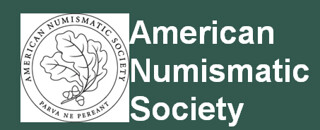 The American Numismatic Society, located in New York City, invites nominations and applications for the position of the Francis D. Campbell Librarian in its Harry W. Bass Jr. Library. The Society is looking for an outgoing, well-educated individual who can assist members and the public with a variety of questions ranging from all periods of history and geographical areas.
The American Numismatic Society, located in New York City, invites nominations and applications for the position of the Francis D. Campbell Librarian in its Harry W. Bass Jr. Library. The Society is looking for an outgoing, well-educated individual who can assist members and the public with a variety of questions ranging from all periods of history and geographical areas.
numismatics.org/wikiuploads/NewsEvents/2014_0909_PR_ANSLibrarianPosition.pdf
NEW BOOK: 1904-O MORGAN DOLLAR ATTRIBUTION
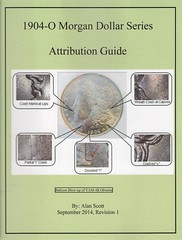 The new 1904-O Morgan
Dollar Series Attribution
Guide, Revision 1 was released
this week by its author,
Alan Scott.
The new 1904-O Morgan
Dollar Series Attribution
Guide, Revision 1 was released
this week by its author,
Alan Scott.
http://vamsandmore.net/
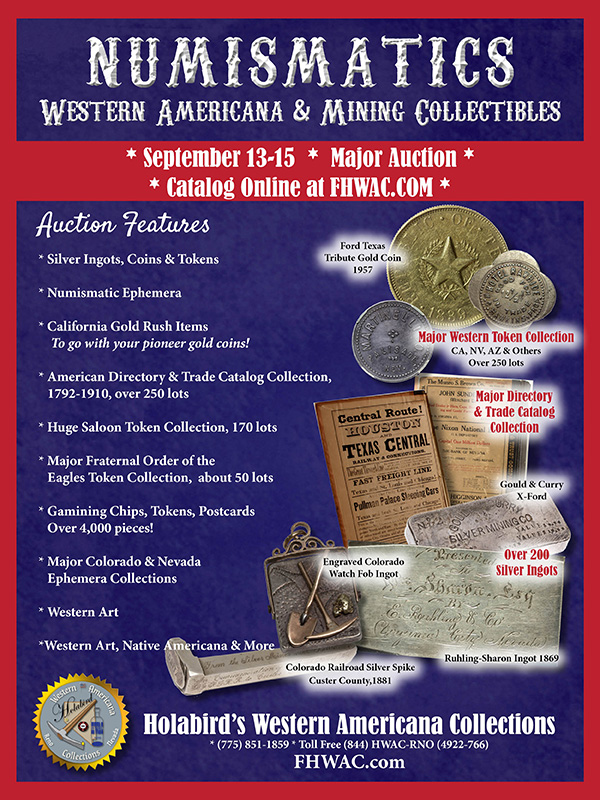
NEW BOOKS IN THE MONETA SERIES: #176-178
 When Orient and Occident Meet, Proceedings of the Round Table of the "Silver Monetary Depreciation and International Relations" program (ANR DAMIN, LabEx TransferS), Osaka, April 4-6, 2014, G. Depeyrot, ed., Collection Moneta, 176, Wetteren, 2014, 354 p ISBN 978-94-91384-44-8
When Orient and Occident Meet, Proceedings of the Round Table of the "Silver Monetary Depreciation and International Relations" program (ANR DAMIN, LabEx TransferS), Osaka, April 4-6, 2014, G. Depeyrot, ed., Collection Moneta, 176, Wetteren, 2014, 354 p ISBN 978-94-91384-44-8
http://www.moneta.be/volumes/moneta_176.htm
http://www.moneta.be/volumes/moneta_177.htm
http://www.moneta.be/volumes/moneta_178.htm
R.L. MILES AND NUMISMATIC LITERATURE

The R.L Miles, Jr. Coin Collection, Part 5
(www.stacksbowers.com/NewsMedia/Blogs/TabId/780/ArtMID
/2678/ArticleID/64731/The-RL-Miles-Jr-Coin-Collection-Part-5.aspx)
MORE ON THE RED BOOK KNOCKOFF
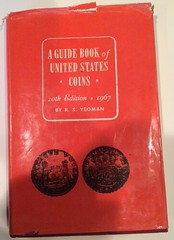 Yes, this definitely is a Chinese knockoff copy of the Red Book. I knew about these at the time and think that most of them were stopped at the border. I have never been able to get a copy and have never even seen one. There were also some similar counterfeit copies of the Yeoman Modern World Coins catalog made at that time. I have seen a few of those around.
Yes, this definitely is a Chinese knockoff copy of the Red Book. I knew about these at the time and think that most of them were stopped at the border. I have never been able to get a copy and have never even seen one. There were also some similar counterfeit copies of the Yeoman Modern World Coins catalog made at that time. I have seen a few of those around.
QUERY: CHINESE RED BOOK KNOCKOFF INFO SOUGHT
(www.coinbooks.org/esylum_v17n37a14.html)
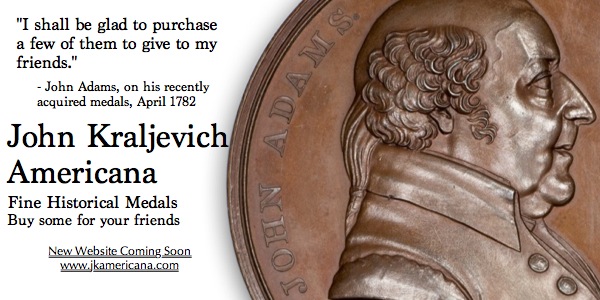
WHITMAN'S 2ND AMENDMENT IMPRINT
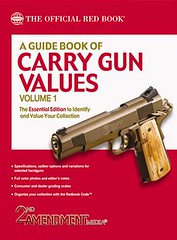 A Guide Book of Carry Gun Values
A Guide Book of Carry Gun Values
A Guide Book of Carry Gun Values, Volume I
(www.whitman.com/store/Inventory/Detail/A-Guide-Book-of-Carry-Gun-Values-Volume-I+0794842593)
NOTES FROM E-SYLUM READERS: SEPTEMBER 14, 2014
THE HERITAGE JAMES SMILLIE ARCHIVE SALE
(www.coinbooks.org/esylum_v17n37a26.html)
12-1: Don Cann , Bryan Money from the Election of 1896
1-2: Paul Joseph (ANACS), Young Numismatists Presentation
2-3: Bill Bugert, 1861 O Half Dollars
3-4: John Frost, Double Dimes & the Amazing Discovery at the CC Mint
www.battlefieldcoinshows.com/Gettysburg.html
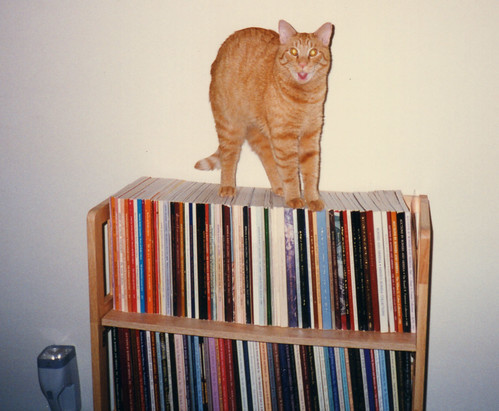
NOTES FROM E-SYLUM READERS: SEPTEMBER 7, 2014 : Paris the Numismatic Literature Watch Cat
(www.coinbooks.org/esylum_v17n37a13.html)
FEATURED WEB SITE: INSTITUTE FOR CONVERSATION
(www.coinbooks.org/esylum_v17n37a40.html)
CONGRESSIONAL GOLD MEDALS FOR 9/11 HEROES
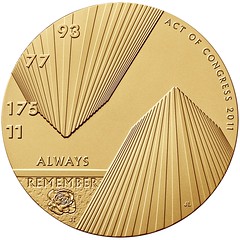
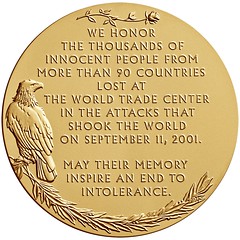
The medal's obverse (heads side) features an abstract representation of two towers. The abstract
lines flowing downward symbolize loss while the lines moving upward represent rising above, hope,
and deliverance from that loss. This configuration also suggests the World Trade Center's Twin
Towers. The numbers 93, 77, 175, and 11 represent the four planes involved in the tragic events of
9/11 and are positioned as if on a clock, representing the times of the crashes. The words “Always
Remember” are set upon a stone wall similar to the wall that bears the names of the victims at the
memorial.

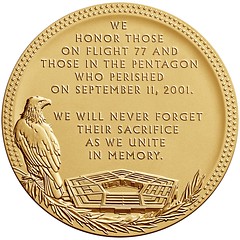
The medal's obverse depicts the rebuilt façade of the Pentagon where Flight 77 crashed. The angle
of view is the angle of the flight path. A single candle and a small bouquet of flowers and greens
signify a sacred memorial at the site. The American flag flies overhead in a united and patriotic
embrace.
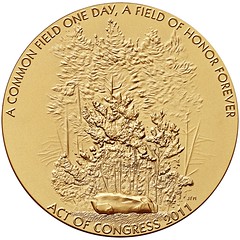
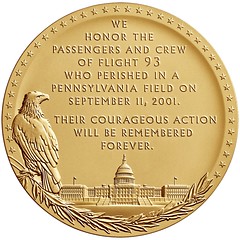
The medal's obverse features the hemlock groves behind the boulder at the Flight 93 Memorial, a
simple reminder of loss and healing.
The reverse features 40 stars on a raised border around the edge of the design, one star for each
victim. The inscription is WE HONOR THE PASSENGERS AND CREW OF FLIGHT 93 WHO
PERISHED ON A PENNSYLVANIA FIELD ON SEPTEMBER 11, 2001. THEIR COURAGEOUS
ACTION WILL BE REMEMBERED FOREVER. The design also features a bald eagle standing
sentinel and clasping branches of laurel signifying an eternal honoring of those who perished in the
tragedies.
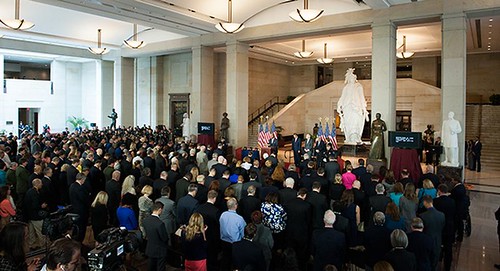
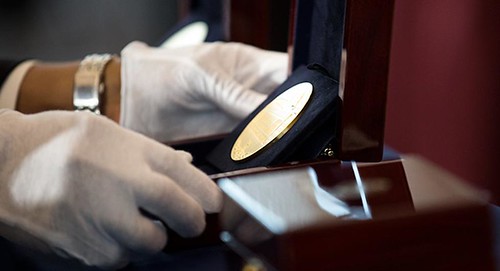
Congressional Gold Medal Awarded to the Fallen Heroes of September 11, 2001
(www.usmint.gov/pressroom/?action=press_release&id=1619)
Congressional Gold Medal ceremony at Capitol
(www.politico.com/gallery/2014/09/congressional-gold-medal-ceremony-at-capitol/002024-028768.html)
THE BOOK BAZARRE
MORE ON THE MONNAIE DE PARIS MEDAL CATALOGS
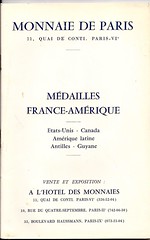 For some years I have had a thin cardboard cover publication of 60 pages, dated Fevrier 1968 covering "Medailles France-Amerique" (see cover illustration). It not only describes restrikes from the 1600s but also newer medals such as the Duke Ellington medal from 1967. Everything listed was available for sale in 1968. I believe very few of these medals are available for sale today.
For some years I have had a thin cardboard cover publication of 60 pages, dated Fevrier 1968 covering "Medailles France-Amerique" (see cover illustration). It not only describes restrikes from the 1600s but also newer medals such as the Duke Ellington medal from 1967. Everything listed was available for sale in 1968. I believe very few of these medals are available for sale today.
MONNAIE DE PARIS COMMEMORATIVE MEDAL CATALOGS
(www.coinbooks.org/esylum_v17n37a22.html)
PARIS MINT PRIVY MARKS APPEARING ON MEDALS
Director and Engraver Edge Marks of the Paris Mint
(www.exonumia.com/art/art_04.htm)
MONNAIE DE PARIS COMMEMORATIVE MEDAL CATALOGS
(www.coinbooks.org/esylum_v17n37a22.html)
A MECKLENBURG DECLARATION CITATION
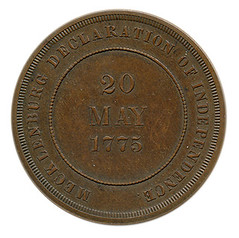 The Mecklenburg County Resolves were published in the New York Journal, June 29, 1775.
The Mecklenburg County Resolves were published in the New York Journal, June 29, 1775.
MECKLENBURG DECLARATION OF INDEPENDENCE CENTENNIAL MEDAL
(www.coinbooks.org/esylum_v17n37a20.html)
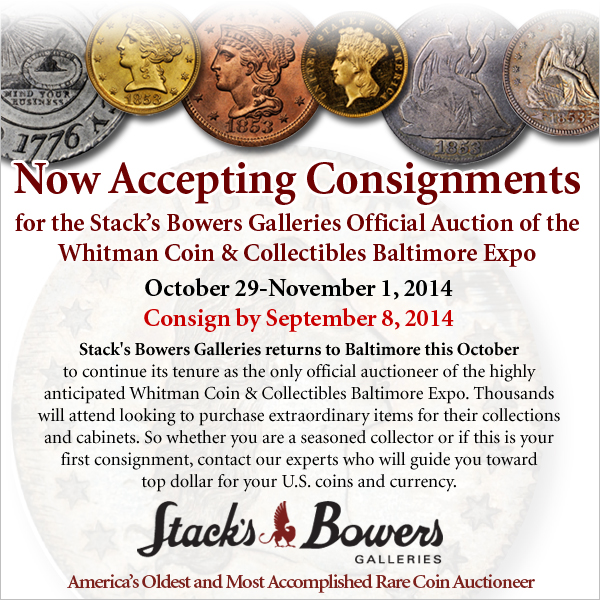
MORE ON CONFEDERATE MINTING IN NEW ORLEANS

WHY THE CONFEDERATES STOPPED MINTING IN NEW ORLEANS
(www.coinbooks.org/esylum_v17n37a15.html)
THE 'CONFEDERATE' 1861-D GOLD DOLLAR
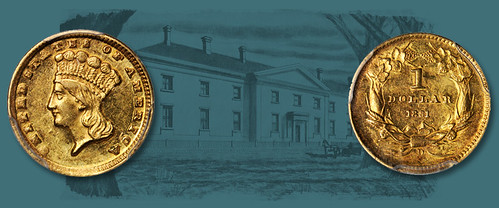
Famous “Confederate” 1861-D Gold Dollar Rarity Highlights Our October 2014 PNG Auction Sale From the Milt Tretiak Collection
(www.stacksbowers.com/NewsMedia/Blogs/TabId/780/ArtMID/
2678/ArticleID/64735/Famous-%E2%80%9CConfederate%E2%80%9D
-1861-D-Gold-Dollar-Rarity-Highlights-Our-October-2014-PNG
-Auction-Sale-From-the-Milt-Tretiak-Collection.aspx)
VALUING THE NEWLY-FOUND OAK TREE THREEPENCE
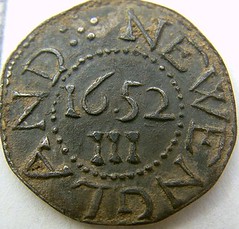 While that is a really, really cool find for anyone to make. their estimate of value was -- let's say -- a little bit off. That is an Oak Tree Threepence (Noe-23, Salmon 1-A), considered to be rarity-6.
While that is a really, really cool find for anyone to make. their estimate of value was -- let's say -- a little bit off. That is an Oak Tree Threepence (Noe-23, Salmon 1-A), considered to be rarity-6.
Rare 17th century coin found in English field
(forums.collectors.com/messageview.cfm?catid=26&threadid=926377&STARTPAGE=1)
OAK TREE THREEPENCE UNEARTHED IN ENGLAND
(www.coinbooks.org/esylum_v17n37a31.html)
THE BOOK BAZARRE
THE LYN KNIGHT WORLD REPLACEMENT NOTE SALE

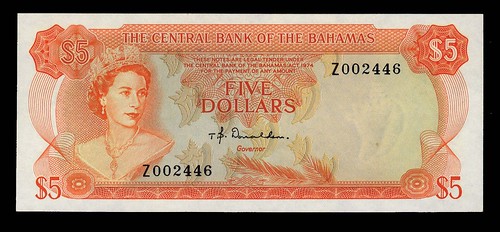
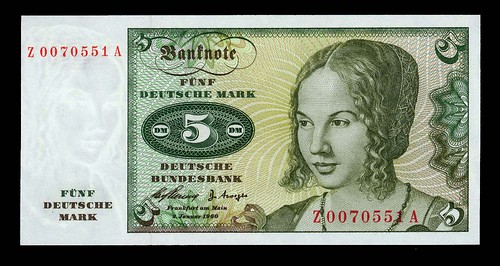
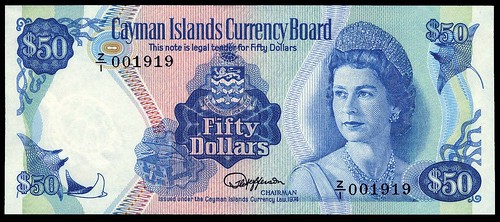
www.lynknight.com/LK/
PHILIP DIEHL ON FIRST STRIKE COINAGE
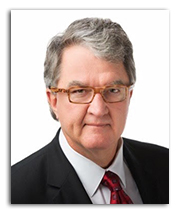 I read with interest Michael Bugeja's July 7 CoinUpdate article about “first releases” and “Early Releases®” and the readers' comments that followed.
I read with interest Michael Bugeja's July 7 CoinUpdate article about “first releases” and “Early Releases®” and the readers' comments that followed.
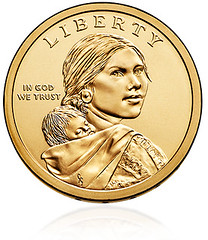 ... when we were planning the launch of the Golden Dollar we conducted market research with the Federal Reserve and major banks to ensure the successful distribution of the coin. They threw us a curveball by indicating they had little interest in ordering the coin, considering their experience with the Susan B. Anthony dollar. We also knew they were unfriendly to a dollar coin for business reasons.
... when we were planning the launch of the Golden Dollar we conducted market research with the Federal Reserve and major banks to ensure the successful distribution of the coin. They threw us a curveball by indicating they had little interest in ordering the coin, considering their experience with the Susan B. Anthony dollar. We also knew they were unfriendly to a dollar coin for business reasons.
The Real Diehl: Let's Get Real About the Issue of First Strike Coinage
(/www.coinweek.com/education/coin-grading/ngc/real-diehl-lets-get-real-issue-first-strike-coinage/)
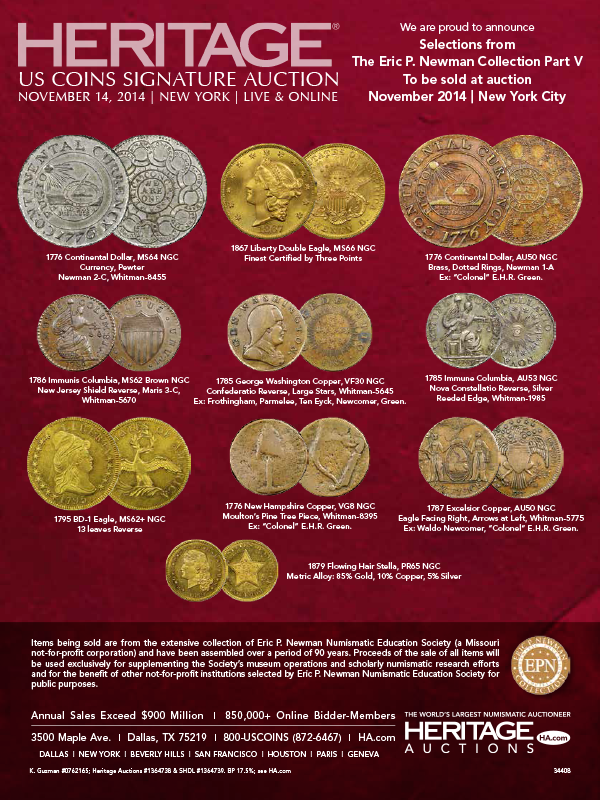
NEW ORLEANS MINT REOPENING SILVER BAR QUESTIONED
SILVER BAR FOR NEW ORLEANS MINT REOPENING
(www.coinbooks.org/esylum_v17n37a19.html)
FIRST DOLLAR ADJUSTED IN THE NEW ORLEANS MINT
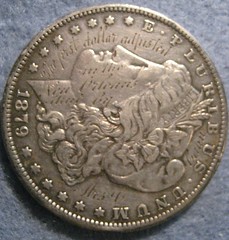
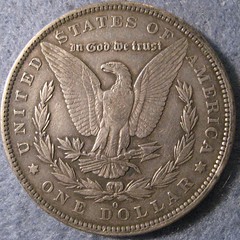
I asked our resident U.S. Mint process expert Roger Burdette about this, and his response follows, along with a better view of the inscription. Thanks!
-Editor

SILVER BAR FOR NEW ORLEANS MINT REOPENING
(www.coinbooks.org/esylum_v17n37a19.html)
WHITMAN CALLS FOR CHERRYPICKERS' VOLUNTEERS
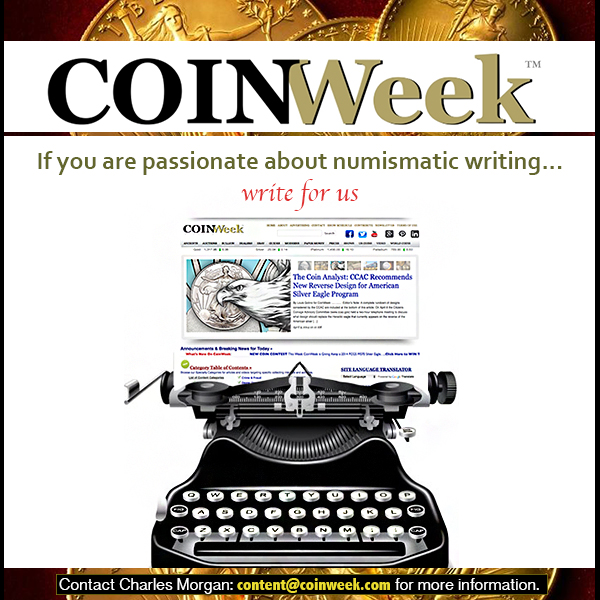
THE 'ALONGSIDE NIGHT' GOLD LIBERTY COIN
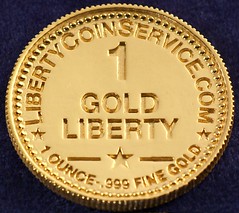 The US government can hardly maintain public order. The black market becomes ever more important due to rising inflation. Those who dare criticise the system are arrested by the FBI. But resistance is forming. A private gold currency saves the US economy (and the world).
The US government can hardly maintain public order. The black market becomes ever more important due to rising inflation. Those who dare criticise the system are arrested by the FBI. But resistance is forming. A private gold currency saves the US economy (and the world).
Coin dealer saves US economy
(coinsweekly.com/en/News/4?&id=2999)
Alongside Night
(www.alongsidenightmovie.com/)
COINS STRUCK FOR LIBERTARIAN MOVIES
(www.coinbooks.org/esylum_v17n25a18.html)
U.S. MARSHALS HUNT FOR TOMMY THOMPSON
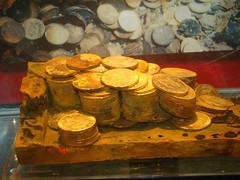 These days, off the South Carolina coast, a new expedition is underway to recover more treasure from the “Ship of Gold,” the sunken SS Central America. Inside the mess hall of the barge making the voyage hangs a “Wanted” poster of the man who first found the ship.
These days, off the South Carolina coast, a new expedition is underway to recover more treasure from the “Ship of Gold,” the sunken SS Central America. Inside the mess hall of the barge making the voyage hangs a “Wanted” poster of the man who first found the ship.
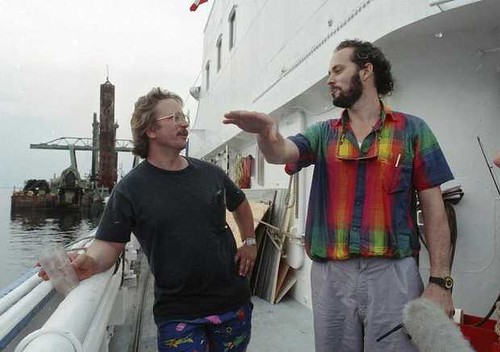
Bob Evans and Tommy Thompson June 18, 1991
‘Plague of the gold' – treasure hunter turned fugitive
(www.newsobserver.com/2014/09/13/4147497/plague-of-the-gold-treasure-hunter.html)
WAYNE'S NUMISMATIC DIARY: SEPTEMBER 14, 2014
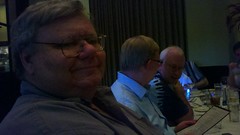
 Roger, Wayne Homren, Steve, Joe, Dave
Roger, Wayne Homren, Steve, Joe, Dave
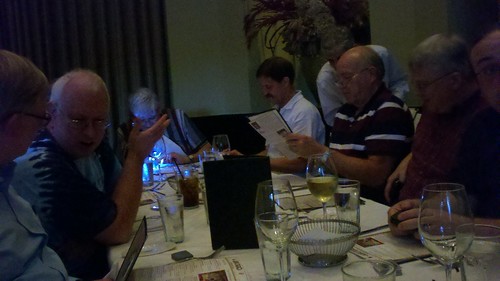
On left: Wayne Homren, Steve, Julian,
On right: Wayne Herndon, Mike Packard, Jon Radel, Eric Schena
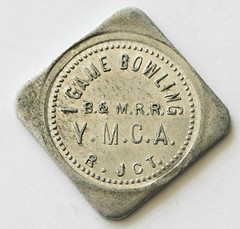
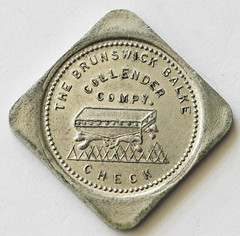
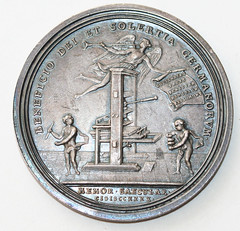
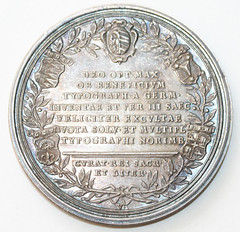
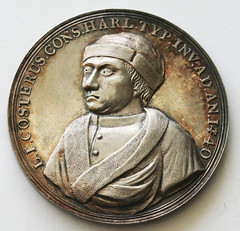
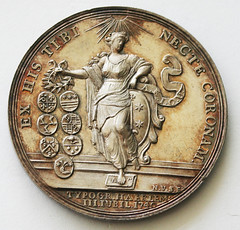
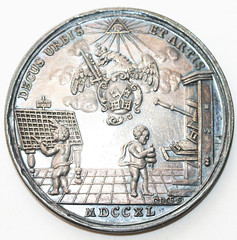

FORGET YOUR PASSWORD? NO PROBLEM -- HERE ARE 4 BODY PARTS THAT COULD AUTHENTICATE YOUR IDENTITY ONLINE
(www.nextgov.com/cybersecurity/2014/09/forget-your-password-no-problem-here-are-4-body-parts-could-authenticate-your-identity-online/93395/)

Archives International Auctions, Part XX
Hong Kong 3
No earlier than 6PM local time
![]()
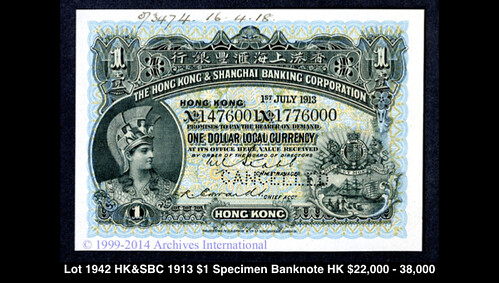
1580 Lemoine Avenue, Suite #7
Fort Lee, NJ 07024
Phone: 201-944-4800
Email:
info@archivesinternational.com
WWW.ARCHIVESINTERNATIONAL.COM
A DESIGN CONTEST FOR THE POUND COIN REVERSE
What would you put on a pound coin?
(www.thetimes.co.uk/tto/news/uk/article4204726.ece)
Twitter pranksters make a mockery of George Osborne's competition to design a new pound coin
(metro.co.uk/2014/09/12/twitter-pranksters-make-a-mockery-of-george-osbornes-competition-to-design-a-new-pound-coin-4866815/)
CHRISTIE'S TO SELL JOHN IRVING ARCTIC MEDAL
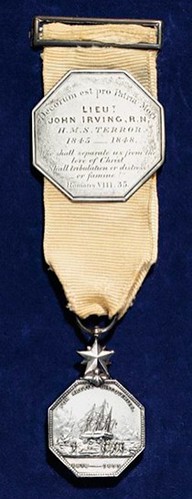 Christie's announced the sale of the Arctic Medal awarded posthumously to Franklin's Third Officer on HMS Terror, John Irving, RN (estimate: £20,000-£30,000) in Christie's Travel, Science and Natural History sale, 8 October 2014. Consigned for sale by Irving's descendant, the medal serves as poignant souvenir recalling Franklin's ill-fated expedition. The appearance of this rare Arctic Medal for auction coincides with the announcement by the Canadian Prime Minister, Stephen Harper, that one of Franklin's fabled ships has been found in the Arctic.
Christie's announced the sale of the Arctic Medal awarded posthumously to Franklin's Third Officer on HMS Terror, John Irving, RN (estimate: £20,000-£30,000) in Christie's Travel, Science and Natural History sale, 8 October 2014. Consigned for sale by Irving's descendant, the medal serves as poignant souvenir recalling Franklin's ill-fated expedition. The appearance of this rare Arctic Medal for auction coincides with the announcement by the Canadian Prime Minister, Stephen Harper, that one of Franklin's fabled ships has been found in the Arctic.
John Irving to his sister, Woolwich, 18 April 1845
Arctic medal from Franklin's expedition at Christie's South Kensington in October
(artdaily.com/news/72825/Arctic-medal-from-Franklin-s-expedition-at-Christie-s-South-Kensington-in-October#.VBWhNPmzFYE)
COINAGE OF THE BARBARIAN INVADERS
The people we know as Huns were one such confederation. Around 370 CE, they appeared on the horizon of the Roman world (on the steppes north of the Black Sea), setting in motion waves of migration that German historians call the Völkerwanderung – the “wandering of the peoples.”

In our day, a Goth is a sensitive young person who favors dark music, attire and makeup. In the waning years of the Roman Empire it meant something different. For centuries, Gothic tribes lived along the Roman frontier, often as enemies, sometimes as allies.
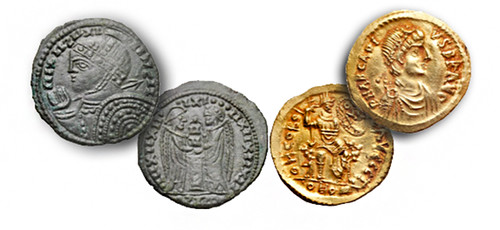
Ancient Coins: Coinage of the Barbarian Invaders
(www.coinweek.com/featured-news/ancient-coins-coinage-barbarian-invaders/)
THE BOOK BAZARRE
HASLEMERE AND THE LEGENDARY ANCIENT COIN FORGERS
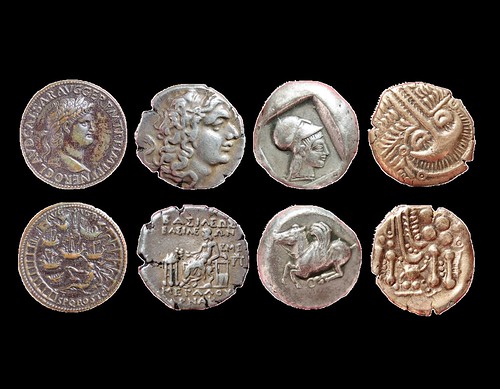
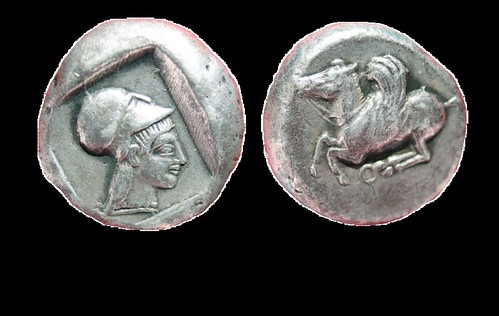
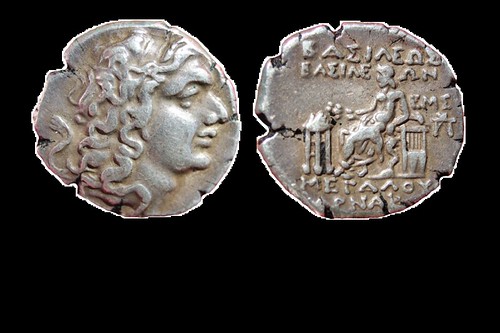
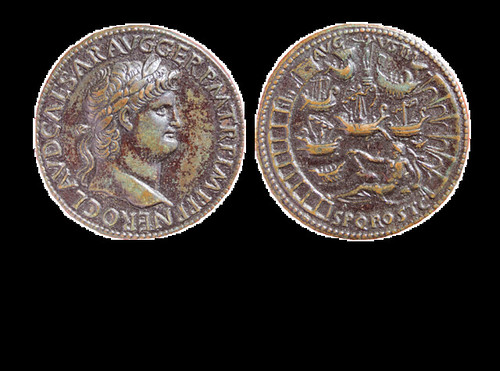
The Haslemere Forger had improved his work greatly from 1960 to 1991. At the end of that period, he was capable of work rivaling that of Constantine Christodoulos. If he continued to improve his work after that time, he may very well have been capable of forgeries as good as Becker or Cavino.
Modern Celtic Fakes 5 – Haslemere vs. the legendary forgers
(vanarsdellcelticcoinageofbritain.com/coin_articles/v2014e.html)
WORLD'S FIRST ECCENTRIC BIMETALLIC COIN
Portugal Issues World's First Eccentric Bimetallic Coin
(news.coinupdate.com/portugal-issues-worlds-first-eccentric-bimetallic-coin-4475/)

IS THERE REALLY SUCH A THING AS A COIN SHOP?
http://www.davewcoins.com/newsletter
BALDWIN'S TO SELL 18TH CENTURY BRITISH TOKENS
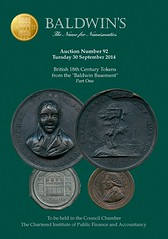 Tokens from the “Baldwin Basement” emerge
Tokens from the “Baldwin Basement” emerge
at auction for the first time in over half-a-century
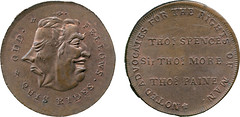
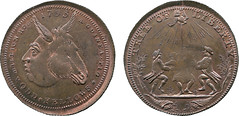
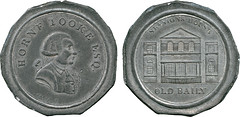
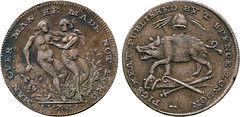

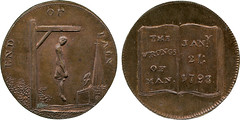
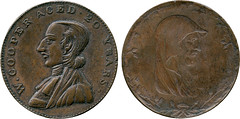 Prolific token maker Skidmore accounted for nearly a quarter of all tokens varieties produced in the late 18th Century. A unique example of a medley token in the sale, originating in Skidmore's manufactory uses the obverse die for a William Cooper Halfpenny and the reverse showing an impression of a Parys Mine Company Druid. [Lot 581, est. £300-400] left.
Prolific token maker Skidmore accounted for nearly a quarter of all tokens varieties produced in the late 18th Century. A unique example of a medley token in the sale, originating in Skidmore's manufactory uses the obverse die for a William Cooper Halfpenny and the reverse showing an impression of a Parys Mine Company Druid. [Lot 581, est. £300-400] left.
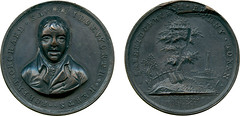 One of the many tokens in the sale that once formed part of the celebrated F S Cokayne Collection is Robert Orchard's Sawbridgeworth Penny. Cokayne began collecting coins with his brother in the late 1880s and was one of many that began to collect these tokens contemporaneously. He traded with notable collectors of the period and participated in every public token auction in the UK for over 50 years. It was a standing rule at Baldwin's that staff could not leave on Friday until a new parcel of tokens was posted to Mr Cokayne's offices on Montagu Square. One of only five known examples, Baldwin's purchased this token on Cokayne's behalf in 1930 for £31, it is now estimated at £8,000-10,000 [Lot 83] right.
One of the many tokens in the sale that once formed part of the celebrated F S Cokayne Collection is Robert Orchard's Sawbridgeworth Penny. Cokayne began collecting coins with his brother in the late 1880s and was one of many that began to collect these tokens contemporaneously. He traded with notable collectors of the period and participated in every public token auction in the UK for over 50 years. It was a standing rule at Baldwin's that staff could not leave on Friday until a new parcel of tokens was posted to Mr Cokayne's offices on Montagu Square. One of only five known examples, Baldwin's purchased this token on Cokayne's behalf in 1930 for £31, it is now estimated at £8,000-10,000 [Lot 83] right.
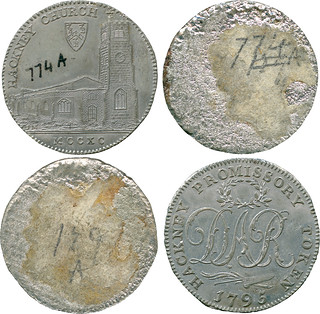
18TH CENTURY BRITISH TOKEN REFERENCES
As collectors got involved, makers dreamed up a number of offbeat metal and die marriage varieties for the collector market. I could never get much interested in these concoctions, but for collectors today it can be difficult to sort the "real" tokens from the pseudo-tokens.
The Introduction to the catalogue of Baldwin's Auction 92 of 18th century British tokens (written by Gary Groll) discusses the complexity of the series and the firm's decision on the arrangement of the catalog. Here's an excerpt.
-Editor
 The provincial tokens issued in the late 18th Century in England, Wales, Scotland and Ireland form a complex series, essentially composed of a variety of types (as circulating coinage, store cards, political and social commentary, private tokens, and those made for collectors) and for a variety of purposes. There are genuine issues, counterfeits, medley tokens (mules and edge varieties), specious fabrications, restrikes, off metal trials and presentation pieces, odd concoctions, as well as surviving artist's proofs and die trials. As a result, they may be organised, arranged, catalogued or collected in any one of a number of ways.
The provincial tokens issued in the late 18th Century in England, Wales, Scotland and Ireland form a complex series, essentially composed of a variety of types (as circulating coinage, store cards, political and social commentary, private tokens, and those made for collectors) and for a variety of purposes. There are genuine issues, counterfeits, medley tokens (mules and edge varieties), specious fabrications, restrikes, off metal trials and presentation pieces, odd concoctions, as well as surviving artist's proofs and die trials. As a result, they may be organised, arranged, catalogued or collected in any one of a number of ways.
www.baldwin.co.uk/auction-92/
THE BOOK BAZARRE
RARE £10 MILLION UK TREASURY BILL OFFERED
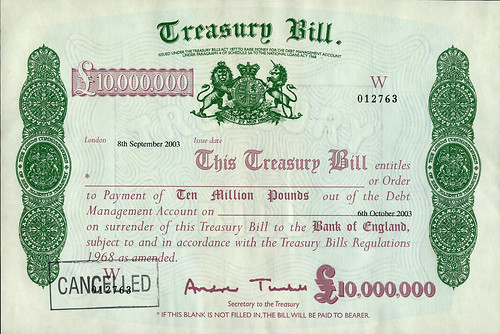
FINANCES AFLOAT – THE FIRST £10 MILLION
TREASURY BILL TO BE AUCTIONED
16 Bolton Street,
London W1J 8BQ
Telephone: 020 7016 1700.
E-mail: auctions@dnw.co.uk
www.dnw.co.uk
BANK OF ISRAEL ANNOUNCES NEW 50 SHEKEL BANKNOTE
 The Bank of Israel on Wednesday released the first samples to the Israeli market of its new 50 shekel (just under $15) banknote that is poised to enter circulation.
The Bank of Israel on Wednesday released the first samples to the Israeli market of its new 50 shekel (just under $15) banknote that is poised to enter circulation.
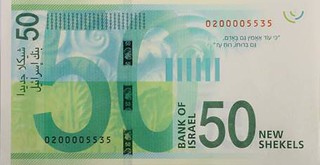 On the back, microtext from his poem "I Believe" is printed reading "For I will continue to believe in man, in his spirit, a spirit of strength."
On the back, microtext from his poem "I Believe" is printed reading "For I will continue to believe in man, in his spirit, a spirit of strength."
Bank of Israel Unveils New 50 Shekel Bill
(www.israelnationalnews.com/News/News.aspx/184963#.VBSYjvmzFYE)
WORLD'S LARGEST COIN MOSAIC RECORD SET
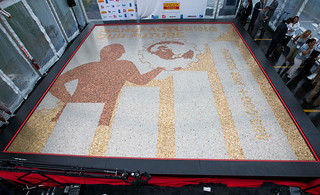 Today, the manufacturing industry made history, breaking the Guinness World Record for the "World's Largest Coin Mosaic" during the International Manufacturing Technology Show. In an effort to raise awareness of the vital role the manufacturing industry plays in the U.S. economy and the opportunities it presents for the next generation of workers, the mosaic incorporated more than $65,000 worth of coins - the amount of money manufacturing contributes to the U.S. economy each second.
Today, the manufacturing industry made history, breaking the Guinness World Record for the "World's Largest Coin Mosaic" during the International Manufacturing Technology Show. In an effort to raise awareness of the vital role the manufacturing industry plays in the U.S. economy and the opportunities it presents for the next generation of workers, the mosaic incorporated more than $65,000 worth of coins - the amount of money manufacturing contributes to the U.S. economy each second.
Guinness World Record Set During America's Largest Manufacturing Technology Show
(www.manufacturing.net/news/2014/09/guinness-world-record-set-during-americas-largest-manufacturing-technology-show)
FEATURED WEB SITE: THE COLUMBIA FARTHING
This week's Featured Web Site is about the Columbia Farthing. These copper pieces were likely made and used in England post 1820. They are likely Evasion or unofficial farthings, but little more is known for certain. There was some discussion about these enigmatic pieces on the Yahoo Colonial Coins group. Thanks to Will Nipper for posting the link.
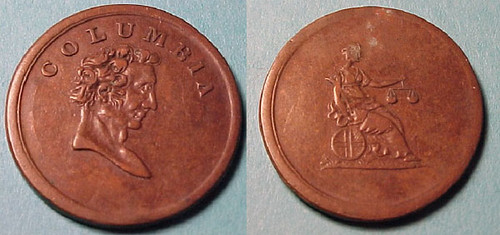
members.optusnet.com.au/~ihartshorn/columbia.htm

